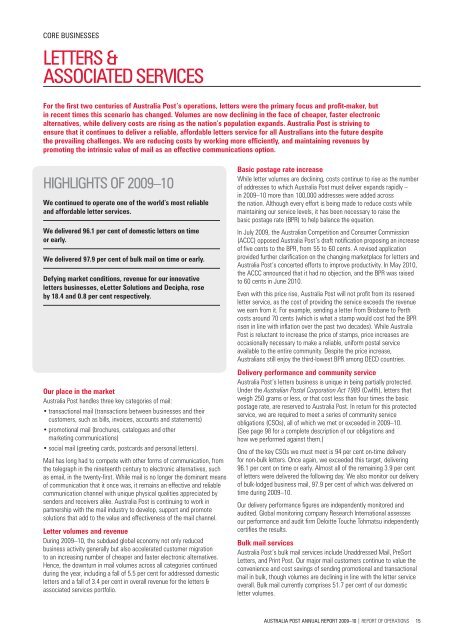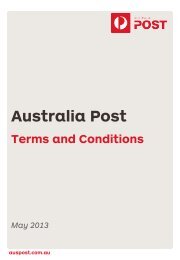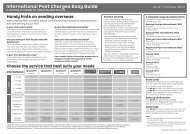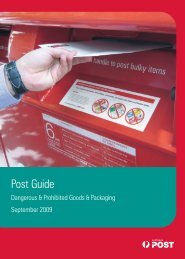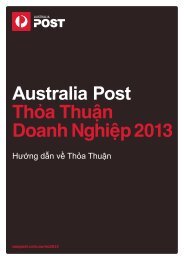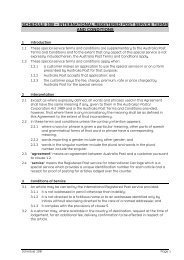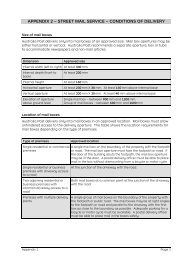2009-10 Annual Report - Australia Post
2009-10 Annual Report - Australia Post
2009-10 Annual Report - Australia Post
You also want an ePaper? Increase the reach of your titles
YUMPU automatically turns print PDFs into web optimized ePapers that Google loves.
CORE BUSINESSES<br />
LETTERS &<br />
ASSOCIATED SERVICES<br />
For the fi rst two centuries of <strong>Australia</strong> <strong>Post</strong>’s operations, letters were the primary focus and profi t-maker, but<br />
in recent times this scenario has changed. Volumes are now declining in the face of cheaper, faster electronic<br />
alternatives, while delivery costs are rising as the nation’s population expands. <strong>Australia</strong> <strong>Post</strong> is striving to<br />
ensure that it continues to deliver a reliable, affordable letters service for all <strong>Australia</strong>ns into the future despite<br />
the prevailing challenges. We are reducing costs by working more effi ciently, and maintaining revenues by<br />
promoting the intrinsic value of mail as an effective communications option.<br />
HIGHLIGHTS OF <strong>2009</strong>–<strong>10</strong><br />
We continued to operate one of the world’s most reliable<br />
and affordable letter services.<br />
We delivered 96.1 per cent of domestic letters on time<br />
or early.<br />
We delivered 97.9 per cent of bulk mail on time or early.<br />
Defying market conditions, revenue for our innovative<br />
letters businesses, eLetter Solutions and Decipha, rose<br />
by 18.4 and 0.8 per cent respectively.<br />
Our place in the market<br />
<strong>Australia</strong> <strong>Post</strong> handles three key categories of mail:<br />
• transactional mail (transactions between businesses and their<br />
customers, such as bills, invoices, accounts and statements)<br />
• promotional mail (brochures, catalogues and other<br />
marketing communications)<br />
• social mail (greeting cards, postcards and personal letters).<br />
Mail has long had to compete with other forms of communication, from<br />
the telegraph in the nineteenth century to electronic alternatives, such<br />
as email, in the twenty-fi rst. While mail is no longer the dominant means<br />
of communication that it once was, it remains an effective and reliable<br />
communication channel with unique physical qualities appreciated by<br />
senders and receivers alike. <strong>Australia</strong> <strong>Post</strong> is continuing to work in<br />
partnership with the mail industry to develop, support and promote<br />
solutions that add to the value and effectiveness of the mail channel.<br />
Letter volumes and revenue<br />
During <strong>2009</strong>–<strong>10</strong>, the subdued global economy not only reduced<br />
business activity generally but also accelerated customer migration<br />
to an increasing number of cheaper and faster electronic alternatives.<br />
Hence, the downturn in mail volumes across all categories continued<br />
during the year, including a fall of 5.5 per cent for addressed domestic<br />
letters and a fall of 3.4 per cent in overall revenue for the letters &<br />
associated services portfolio.<br />
Basic postage rate increase<br />
While letter volumes are declining, costs continue to rise as the number<br />
of addresses to which <strong>Australia</strong> <strong>Post</strong> must deliver expands rapidly –<br />
in <strong>2009</strong>–<strong>10</strong> more than <strong>10</strong>0,000 addresses were added across<br />
the nation. Although every effort is being made to reduce costs while<br />
maintaining our service levels, it has been necessary to raise the<br />
basic postage rate (BPR) to help balance the equation.<br />
In July <strong>2009</strong>, the <strong>Australia</strong>n Competition and Consumer Commission<br />
(ACCC) opposed <strong>Australia</strong> <strong>Post</strong>’s draft notifi cation proposing an increase<br />
of fi ve cents to the BPR, from 55 to 60 cents. A revised application<br />
provided further clarifi cation on the changing marketplace for letters and<br />
<strong>Australia</strong> <strong>Post</strong>‘s concerted efforts to improve productivity. In May 20<strong>10</strong>,<br />
the ACCC announced that it had no objection, and the BPR was raised<br />
to 60 cents in June 20<strong>10</strong>.<br />
Even with this price rise, <strong>Australia</strong> <strong>Post</strong> will not profi t from its reserved<br />
letter service, as the cost of providing the service exceeds the revenue<br />
we earn from it. For example, sending a letter from Brisbane to Perth<br />
costs around 70 cents (which is what a stamp would cost had the BPR<br />
risen in line with infl ation over the past two decades). While <strong>Australia</strong><br />
<strong>Post</strong> is reluctant to increase the price of stamps, price increases are<br />
occasionally necessary to make a reliable, uniform postal service<br />
available to the entire community. Despite the price increase,<br />
<strong>Australia</strong>ns still enjoy the third-lowest BPR among OECD countries.<br />
Delivery performance and community service<br />
<strong>Australia</strong> <strong>Post</strong>’s letters business is unique in being partially protected.<br />
Under the <strong>Australia</strong>n <strong>Post</strong>al Corporation Act 1989 (Cwlth), letters that<br />
weigh 250 grams or less, or that cost less than four times the basic<br />
postage rate, are reserved to <strong>Australia</strong> <strong>Post</strong>. In return for this protected<br />
service, we are required to meet a series of community service<br />
obligations (CSOs), all of which we met or exceeded in <strong>2009</strong>–<strong>10</strong>.<br />
(See page 98 for a complete description of our obligations and<br />
how we performed against them.)<br />
One of the key CSOs we must meet is 94 per cent on-time delivery<br />
for non-bulk letters. Once again, we exceeded this target, delivering<br />
96.1 per cent on time or early. Almost all of the remaining 3.9 per cent<br />
of letters were delivered the following day. We also monitor our delivery<br />
of bulk-lodged business mail, 97.9 per cent of which was delivered on<br />
time during <strong>2009</strong>–<strong>10</strong>.<br />
Our delivery performance fi gures are independently monitored and<br />
audited. Global monitoring company Research International assesses<br />
our performance and audit fi rm Deloitte Touche Tohmatsu independently<br />
certifi es the results.<br />
Bulk mail services<br />
<strong>Australia</strong> <strong>Post</strong>’s bulk mail services include Unaddressed Mail, PreSort<br />
Letters, and Print <strong>Post</strong>. Our major mail customers continue to value the<br />
convenience and cost savings of sending promotional and transactional<br />
mail in bulk, though volumes are declining in line with the letter service<br />
overall. Bulk mail currently comprises 51.7 per cent of our domestic<br />
letter volumes.<br />
AUSTRALIA POST ANNUAL REPORT <strong>2009</strong>–<strong>10</strong> | REPORT OF OPERATIONS 15


